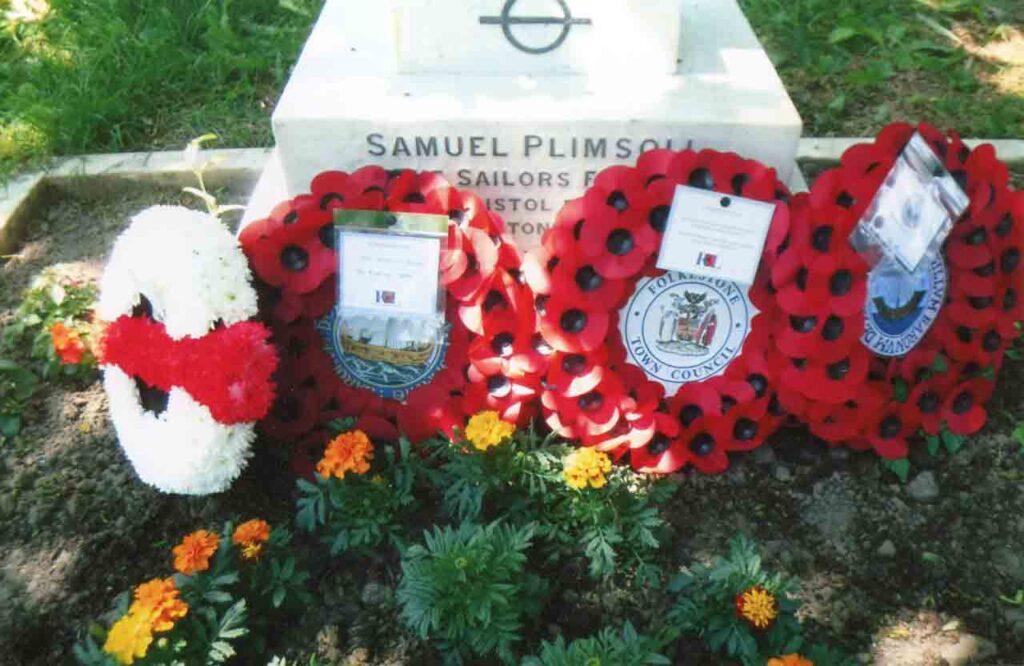Samuel Plimsoll’s grave at St Martin’s Church Photo: Ray Duff
Words and pictures by Ray Duff – On Saturday, about 40 people gathered at the annual event to honour Samuel Plimsoll, a British social reformer and politician who fought for the safety of seamen in the 19th century.
He is best known for creating the Plimsoll line, a mark on a ship’s hull that shows the safe loading limit.
This year marked 125 years since his death in Folkestone in 1898.

L-R The 2023 Wreaths: Plimsoll group, Hythe Town, Folkestone Town & New Romney
The event was attended by several local dignitaries, including the mayors of Folkestone, Hythe and New Romney. It started with a welcome speech by Rev Frank Conley, who shared his personal experience of sailing on the North Sea. The attendees then sang a seafarers song and laid wreaths on Plimsoll’s grave.
The event also featured a talk by former Folkestone mayor Cllr Nicola Keen and two members of the commemoration group, Michael Foad and Angela Conyers. They discussed why Plimsoll’s work is still relevant today.
Plimsoll’s biographer, Nicolette Jones, was unable to attend, so her speech was read by Mr Foad.
The event ended with a song composed in tribute to Plimsoll, followed by tea and cakes in the church.
Next year, 2024, will be the 200th anniversary of Plimsoll’s birth in Bristol in 1824. The commemoration group is planning a bigger event and other activities to celebrate his life and achievements. They hope to connect with other events around the country that will honour Plimsoll’s bicentenary.
Speech by Nicolette Jones at the annual commemoration of Samuel Plimsoll at St Martin’s Church, Cheriton on 3 June 2023.
Last year I was proud and delighted to have the opportunity and the honour to unveil the new mural of Samuel Plimsoll on Folkestone’s Fishing Heritage and History Museum. On that occasion Shane Record, the local artist who created this homage to Sam and embellishment for the town that was his last home,
impressed me with these words.
Speaking of his use of Plimsoll’s reflection in a window, he said: “We’re seeing his reflection which means that we’re standing with him, and becoming part of that collective conscience to take responsibility. “
The use of a reflection invited onlookers to see themselves too: it is an invitation to altruism, to follow the example of Samuel Plimsoll to act on behalf of others and make the world a better place. I wrote my book about Samuel Plimsoll, The Plimsoll Sensation, for the same reason. It is, like Shane’s mural, a celebration of the possibility that determined individuals can make a difference to us all. That ideal never dates.
So why does Samuel Plimsoll deserve our commemorations? A quick recap for those of you who may not know.
Plimsoll led an agitation in the late 19th century with his wife Eliza, and it was an epic legal, social, and political battle for justice. Together they worked to protect sailors against nefarious practices including overloading and the use of unseaworthy ‘coffin-ships’. Plimsoll campaigned for years for an inspection for
seaworthiness and a load line on the side of merchant ships, to set a limit on how deeply in the water they could safely sit.
He took on wealthy shipowners who loaded ships as deeply in the water as they could in order to make as much profit as possible, pocketing insurance if the ships sank, while it was sailors’ lives that were sacrificed.
And sometimes the insurance was a scam that over-represented the worth of the vessel and its cargo.
Challenging the shipowners, including some of his fellow MPs, led to libel cases and vilification that almost ruined Plimsoll, but he was fortified by his faith and popular with the public; he was the subject of plays, novels, street ballads and music hall songs. With the support of the nation, he faced down his enemies, came close to ousting Disraeli’s government and achieved lasting safety measures for merchant sailors, including the Plimsoll line, the load line that immediately bore his name.
The load line eventually became an international standard and it is impossible to quantify the number of lives it has saved.
The timeless aspect of this tale is that it is a story of those who make the profit being separate people from those who take the risk. This is a division we have seen throughout history. And it always seems to lead to those who get richer tending to increase the risk to those who don’t.
I’m sure this audience can come up with examples of its own that fit that template, but may I suggest that the following could have offered causes for Samuel Plimsoll to engage with? Cockle pickers (whose tragedy occurred in Morecambe Bay, where Plimsoll wrote his famous book Our Seamen). Sweat shops, which argue the need to price competitively just as Plimsoll’s opponents did: Plimsoll spoke in his day of ‘competition run mad’. People traffickers, who make money out of others’ suffering. Grenfell Tower, where corners were cut and lives lost. The PPE scandal where suppliers who profited were not the NHS workers risking their lives wearing inadequate protection.
To quote Plimsoll in 1873: “there are in every class of men some who need the law’s restraint who without it have no hesitation in exposing others to risk, if by doing so they can augment their own profits.”
Whatever your political leanings – and Samuel Plimsoll, a Radical liberal MP, also on occasion supported the conservatives when they furthered legislation that protected sailors – you are heirs of Samuel Plimsoll, who was a pioneer of the industrial revolution finding its conscience and of the collective power of
ordinary people, and a promoter of the idea of our responsibility for each other. I very much hope that that idea has not had its day.
I hope you will find from this things to ruminate upon and be inspired by and reasons to be proud of your local hero. Thank you to all on the Plimsoll committee and everyone associated with this event and the church for keeping the flame alive.
Nicolette Jones
